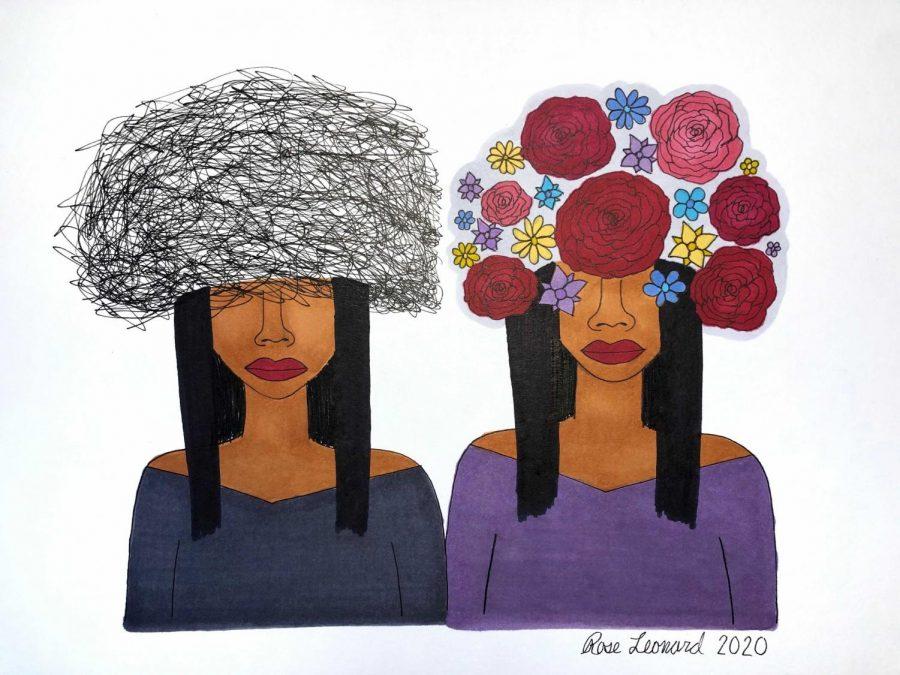Art exhibit asks students to put ‘mind into matter’
Rose Leonard submitted two pieces to the exhibit hoping to share her art and bring awareness to mental illness.
October 28, 2020
In a year filled with tension because of the COVID-19 pandemic and upcoming Nov. 3 elections, the National Alliance on Mental Illness at Pitt is using art to remind students to think about mental health.
“Putting Mind Into Matter: An Art Exhibit on Mental Health & Creativity” is a virtual art gallery showcasing pieces that represent and visualize mental health and mental illness. The Center for Creativity and NAMI at Pitt have created this space as a part of Mental Health Awareness Month for students to submit artwork about their experiences. Through mediums such as poetry, drawing and digital art, students have shared more than 20 pieces about their journeys with mental health, and submissions are still open.
Ace McDonald, the events coordinator for Pitt NAMI, said the group originally intended for the gallery to be in person and feature the work of students and professors in the studio arts department.
“Originally we had the idea of having an in-person art gallery, of course. We thought it would be nice to have at Frick Fine Arts and ask the art students and teachers for their work,” McDonald said. “Then the natural idea came about of having an online exhibit.”
Rose Leonard, who submitted art pieces to the exhibit, said she did so hoping to share her art and bring awareness to mental illness.
“Over quarantine, I started to get more into art. It wasn’t something I did in the past, but it is kind of a new hobby that I picked up,” Leonard, a sophomore psychology major, said. “Mental health is important to me, and NAMI has been a club that I enjoyed doing last year, so I thought it was a good combination of the two and a good way for me to keep up with creating art and hopefully spreading a good message.”
Leonard submitted two works of art, each discussing a different aspect of mental illness. One piece shows how mental illness can overwhelm one’s mind and how opening up can allow for growth. Leonard depicts two individuals in this piece, one whose mind is filled with scribbles, representing negative thoughts, and another whose mind is filled with flowers, which represent positive thoughts.
“I wanted to show how a lot of times with mental illness, our minds can get so consumed with different thoughts and a lot of overwhelming feelings or urges,” Leonard said. “But then with the picture next to it with the mind having flowers and plants, I wanted to show that it can represent growth.”
Leonard said she dedicated her second piece to those struggling with eating disorders. The work shows a weighing scale with no measurement, surrounded by words of affirmation. She explained how, in her personal journey with an eating disorder, she found freedom from the scale in realizing that the number on a scale does not define you.
“Like your weight, it doesn’t tell you anything about your worth, who you are,” Leonard said. “It was an activity that I did when I was in eating disorder treatment and I remember doing that activity helped me see that there [were] so much more important things than just my weight.”
McDonald said she hopes the art exhibit acts as a platform for artists to share their emotions and connect with the audience — especially those who have had difficult experiences with their own mental health.
“All of the pieces are unique to the individuals and show all of the emotions the artists feel when it is hard to express these thoughts and feelings through words,” McDonald said. “We hope viewers can maybe relate to some of the art and know they are not alone in their journeys.”
Many people find that making art about mental illness can be helpful. According to Jennifer Barker, a board-certified art therapist and licensed professional counselor, art therapy focuses on making and interpreting art in the context of mental health.
“The actual act of making art itself can be cathartic, and that’s using art as a form of therapy itself,” Barker said. “And there’s also talking about the art, which is art psychotherapy, where you can talk about the finished product as well.”
While the term “therapy” may make one think of more common behavioral or cognitive therapy, Barker said art therapy is also an option for people of all ages interested in exploring their personal experiences through a more creative lens.
“Anybody can do art therapy, little kids up to older people. I do know that people mostly assume that it would be kids, teenagers, young adults,” Barker said. “In my experience, I think kids and teenagers are more open to experimenting and being a little bit more creative, because I know that sometimes when we grow up, we kind of stop being creative because we don’t allow ourselves to have fun.”
Barker added that art can allow people to have conversations about mental health. She said when people visualize their experiences, it helps a larger audience understand more about mental illness, which is often stigmatized.
“Sometimes it’s really hard to verbalize, ‘Hey, you know what, this is what depression is for me,’” Barker said. “Sometimes it’s really hard to verbalize that and it’s easier just to show it.”
According to the gallery website, “Putting Mind Into Matter” allows students to discuss mental health and relay their experience through art. And according to Barker, art therapy shows, whether it’s through drawing, painting or sculpting, that visualizing your thoughts makes a difference.
“In art therapy, it’s not just coloring books. It can be, because coloring can be zen and calming for some people,” Barker said. “But art therapy is kind of a way to get your emotions out of your brain and put it in a tangible form.”



